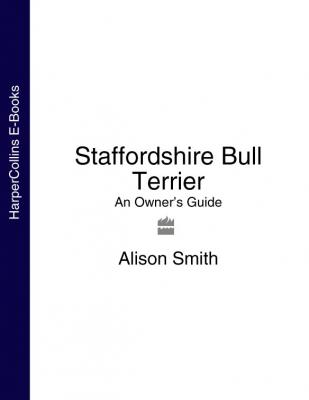ТОП просматриваемых книг сайта:
Staffordshire Bull Terrier: An Owner’s Guide. Alison Smith
Читать онлайн.Название Staffordshire Bull Terrier: An Owner’s Guide
Год выпуска 0
isbn 9780007544301
Автор произведения Alison Smith
Жанр Домашние Животные
Издательство HarperCollins
This owner has total control over her Stafford, who is displaying his full attention. Never allow your new dog off the lead until you have full control over him.
The problem that the DDA does pose to Stafford owners in the UK is that a Stafford may physically resemble the Pit Bull Terrier to a person who is unfamiliar with the breed, which may be confusing to the uninitiated. Never allow your dog to run wild in open spaces until you are 100 per cent sure that you have full control over him, and never encourage him to display any aggression towards people or other dogs. For more information on the Dangerous Dogs Act, see page 126.
Breed Standard
General appearance Smooth-coated, well balanced, of great strength for his size. Muscular, active and agile.
Characteristics Traditionally of indomitable courage and tenacity. Highly intelligent and affectionate, especially with children.
Temperament Bold, fearless and totally reliable.
Head and skull Short, deep through with broad skull. Very pronounced cheek muscles, distinct stop, short foreface, nose black.
Eyes Dark preferred but may bear some relation to coat colour. Round, of medium size, and set to look straight ahead. Eye rims dark.
Ears Rose or half pricked, not large or heavy. Full, drop or pricked ears highly undesirable.
Mouth Lips tight and clean. Jaws strong, teeth large, with a perfect, regular and complete scissor bite, i.e. upper teeth closely overlapping lower teeth and set square to the jaws.
Neck Muscular, rather short, clean in outline gradually widening towards shoulders.
Forequarters Legs straight and well boned, set rather wide apart, showing no weakness at the pasterns, from which point feet turn out a little. Shoulders well laid back with no looseness at elbow.
Body Close-coupled, with level topline, wide front, deep brisket, well sprung ribs; muscular and well defined.
Boldness and courage are two words that are often used to describe the breed.
The Stafford is a strong dog with a distinctive head and a very muscular body.
Hindquarters Well muscled, hocks well let down with stifles well bent. Legs parallel when viewed from behind.
Feet Well padded, strong and of medium size. Nails black in solid coloured dogs.
Tail Medium length, low-set, tapering to a point and carried rather low. Should not curl much and may be likened to an old-fashioned pump handle.
Gait/movement Free, powerful and agile with economy of effort. Legs moving parallel when viewed from front or rear. Discernible drive from hindlegs.
Coat Smooth, short and close.
Colour Red, fawn, white, black or blue, or any one of these colours with white. Any shade of brindle or any shade of brindle with white. Black and tan or liver colour highly undesirable.
Size Desirable height at withers 35.5–40.5cm (14–16in), these heights being related to the weights. Weight: dogs: 12.7–17kg (28–38lb); bitches 11–15.4kg (24–34lb).
Faults Any departure from the foregoing points should be considered a fault and the seriousness with which the fault should be regarded should be in exact proportion to its degree.
Note Male animals should have two apparently normal testicles fully descended into the scrotum.
© The Kennel Club
The Staffordshire Bull Terrier
There is a saying amongst Stafford owners, which is that once you have owned a Stafford, you will never want to have another breed of dog. It is also fairly true to say that you don’t own the breed – it owns you. Such is the extent of the mark a loving Stafford can make on your life as well as your family. I make no apology for the amount of time you will read the word ‘socialized’ in this chapter. Choosing a puppy who has had the benefit of a careful breeder and early socialization is so important.
Is this the breed for you?
Before you buy a Stafford, ask yourself the following questions:
• Are you out at work all day?
• Are you a couch potato?
• Do you live in a flat or bedsit with no green space?
• Are you elderly, infirm or disabled?
• Do you have other dogs?
If you have answered ‘yes’ to any of the above, think carefully before choosing a Stafford as your breed. These dogs thrive on company, lots of exercise, an energetic family and plenty of room to call their own.
However, if you have taken this into consideration and feel that you can surmount any possible problems, then a Stafford may still make a wonderful companion for you.
Why choose a Stafford?
The Staffordshire Bull Terrier is a breed that is noted for its loyalty and devotion, as well as its deep affection for children; for this reason, it is also known as the Nanny Dog. The Stafford is a smooth-coated dog which makes him relatively easy to care for and, as a responsible owner, you will be rewarded with a companion who lives for his family and whose reason for being will begin and end with you.
This dog is extremely energetic and you must be aware that it is essential that you provide above-average exercise and establish a regular routine from an early age for your dog’s mental and physical development – if you are a couch potato, then this breed is probably not right for you. Your dog will thrive on companionship and love and is not a suitable pet if you are away from him for long periods, as this will inevitably lead to difficulty in maintaining the level-headedness required in this physically strong breed.
A Stafford puppy will reward you with his fun-loving personality and deep love of humans, especially children.

